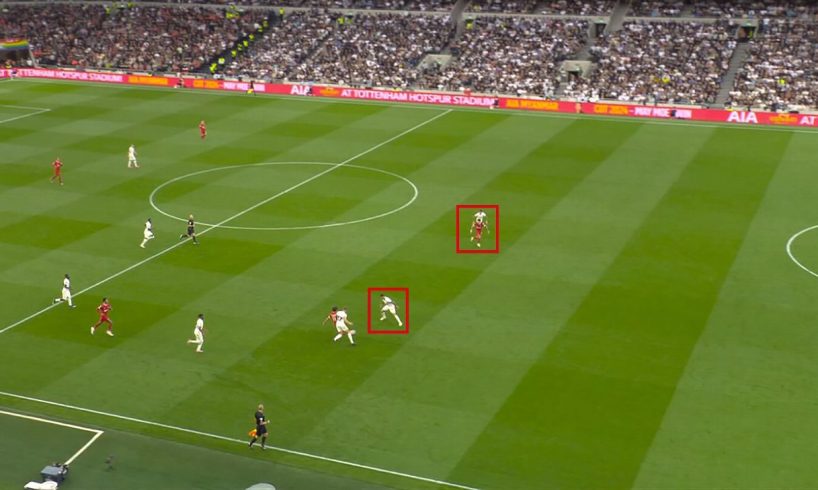
Video Assistant Referee causes controversy every week in the Premier League, but how are decisions made, and are they correct?
After each weekend we take a look at the major incidents, to examine and explain the process both in terms of VAR protocol and the Laws of the Game.
– How VAR decisions have affected every Prem club in 2023-24
– VAR in the Premier League: Ultimate guide
In this week’s VAR Review: What went wrong in the VAR room to disallow Luis Diaz’s goal for Liverpool at Tottenham Hotspur, Curtis Jones’ red card, a missed penalty award for Brentford and the rest of the weekend’s events.
Possible offside overturn: Diaz goal
What happened: Mohamed Salah played Luis Díaz through on goal in the 34th minute, and the forward produced a superb strike across goalkeeper Guglielmo Vicario to score. However, the offside flag immediately went up for offside and the VAR, Darren England, began a check. (watch here.)
VAR decision: No goal.
Luis Diaz appears to be onside from the freeze frame. BBC
VAR review: How do you get a decision both right and disastrously wrong at the same time? It’s a question which refs’ chief Howard Webb and his leadership team are going to have to answer in the coming days and take steps to ensure an inexcusable mistake of this magnitude can never happen again. It’s the biggest error the Premier League has seen.
England and the assistant VAR, Dan Cook, were swiftly both stood down from duties in fixtures on Sunday and Monday, but that kind of action is of no comfort to Jurgen Klopp and his Liverpool players. Both are unlikely to be selected in the upcoming matchweeks.
The VAR made one very simple but inexplicable error: he lost concentration and got the on-field decision incorrect when completing the check.
When the VAR looked at the position of Diaz it quickly became apparent that he was very clearly onside. It was checked with the use of the offside lines in the background — you see proof of this on the VAR feed when the technology operator zooms in to place them.
The VAR zooms in to place the offside lines and knows Luis Diaz is clearly onside. BBC
And this is where it starts to go wrong. England somehow now thinks he is checking a goal, rather than a disallowed goal. If he was confirming an overturn he would lock in the offside lines, but as he now thinks the on-field decision is “goal” there’s no prerequisite to do so when the onside is an obvious one.
England cleared the review so quickly and with such confidence he didn’t even get the opinion of the assistant VAR. Perhaps that was the issue, it was such a regulation “onside” decision that he thought he would wrap it up. And he said “check complete.”
Perhaps the decision was so straightforward that England lost focus and forgot what the on-field decision actually was, because by saying those two words he’s telling the on-field officials their decision is correct. Rather than clearing the goal, he was mistakenly telling the referee the offside call was correct.
Semi-automated offside technology, which Premier League clubs chose not to introduce this season, would have made no difference in this situation because the error is the communication with the referee. England correctly identified that Diaz was onside.
What happened next came so fast there was no time to react within protocol. Just two seconds after the VAR has said “check complete,” Spurs took the free kick which creates a cut-off point. Nothing can be reviewed after a restart (this doesn’t apply to penalties awarded for offences before the half-time or final whistle as play was still active at the time of the offence.)
Editor’s Picks
2 Related
Seven seconds later, the VAR team realised what happened. Panic set in, but they decided they couldn’t go against protocol and let play continue. But in this situation, where a very serious error has been identified within seconds of the restart, football would rather the VAR went against protocol to achieve the fairest outcome for the game. The match should have been stopped.
Not only did the VAR team fail to react, but also the management team who could have stepped in and told the VAR team to roll the game back.
There was the opportunity fix it, and it was missed.
The VAR audio of the incident will be released, which will at least provide transparency for what happened.
Errors in process keep happening, even at the very highest level. At the World Cup last year, France had an injury-time equaliser disallowed against Tunisia when the VAR ruled Antoine Griezmann was offside after the kick off had been taken.
And only a few weeks ago in the Bundesliga, Heidenheim had a penalty ruled out for offside following a foul by Borussia Dortmund’s Sébastien Haller. The officials allowed Haller to be substituted, and during that process the VAR realised the offside decision was incorrect. The penalty was reinstated but Haller, who should have been sent off for pulling back the striker, was no longer on the pitch. He was only shown a yellow card on the bench instead.
That doesn’t excuse what happened in the Premier League on Saturday.
Questions will be asked about the wisdom of allowing England to travel to the United Arab Emirates on Thursday, along with Michael Oliver as a team of English officials, to take charge of a league game between Sharjah and Al-Ain. In terms of preparation it’s no different to a game in the Europa League and Europa Conference League; the officials were back from the UAE on Friday lunchtime. But it’s the optics of travelling to the Middle East to take up an approved, paid job and then coming back to the Premier League and making a huge mistake.
Webb has only been in charge of referees for nine months, yet he faces the huge problem of public perception that refereeing is getting worse. The stats from the Independent Key Incidents Panel suggest standards are improving, but catastrophic mistakes like that at the Tottenham Hotspur Stadium take a hammer to any progress that might be being made.
Liverpool issued a statement on Sunday evening insisting the incident has “undermined sporting integrity,” and you can understand their point. Though the Laws of the Game specifically state that a mistake in the VAR room is no different to a genuine error on the pitch. France appealed to FIFA to try to get their goal back but were told they had no grounds. Usually, a game would only be replayed if there was a misapplication of the laws, rather than just an incorrect decision.
This will now be tough on England and will take some coming back from. Last season he was shadowed by The Guardian and reference was made to how the official seemed mentally exhausted after awarding a controversial late penalty to Manchester City against Fulham. This is going to be even tougher.
Possible red card: Jones challenge on Bissouma
What happened: The game was goalless in the 26th minute when Curtis Jones challenged Yves Bissouma for the ball, and committed a foul. Referee Hooper produced a yellow card, but there was a VAR check for a possible red (watch here.)
VAR decision: Yellow card upgraded to red.
Curtis Jones was sent off for his challenge on Yves Bissouma. BBC
VAR review: Ex-pros and supporters are always split when a player receives a red card when they have played the ball first, but that doesn’t excuse the player for how he may catch an opponent. Jones will no doubt feel himself unlucky to get a red card, but the nature of the challenge always meant a VAR intervention was likely.
As explained last week in the review for Malo Gusto’s red card for Chelsea against Aston Villa, when the replays show that an opponent’s leg has effectively been bent by the tackle that will be seen as evidence of excessive force.
Jones’ foot came off the top of the ball and led to him catching Bissouma high on the shin, and forcing his leg backwards. It’s similar in nature to the dismissal of Manchester United midfielder Casemiro against Southampton last season (though that was a clearer red card due to the way he went into the challenge.)
Jones was unlucky, but a VAR intervention for a red card was always likely.
Some supporters complained that England showed Hooper a freeze-frame of the point of contact as he walked over to the pitchside monitor, effectively pre-judging the review. Yet as the monitor is specifically there to confirm an overturn, a referee is always going to be shown the clearest evidence to support the decision. Hooper will be told as he walks over the screen exactly what he will see, and the kind of replays he will be offered. The referee always has the option of requesting additional angles and replay speeds.
Possible penalty: Handball by Domínguez and Boly
What happened: Brentford had a corner in the final moments of the first half. Nicolás Domínguez jumped for the ball with Vitaly Janelt, and the ball appeared to brush the raised arm of the Forest player as it was nodded on. When the ball bounced inside the area, it was then touched by the hand of Willy Boly.
VAR decision: No penalty.
VAR review: After the decision to penalise Wolves’ João Gomes for his raised arm at Luton Town last weekend, you could understand questions over the first handball by Domínguez. His arm was high and it was hit by the ball. He escapes because it hit him at point-blank range and the arm position was justified when jumping.
Boly had his arm by his side so it would need to be a deliberate handball, and while there was a movement it appeared to be natural rather than specific to push the ball away.
Possible penalty: Turner on Wissa
What happened: Yoane Wissa closed down Forest goalkeeper Matt Turner following a back-pass by Murillo. The Brentford striker got a toe to the ball and pushed it toward goal, and was then caught by Turner as the keeper tried to make the clearance. A defender cleared the ball before it crossed the line.
VAR decision: No penalty.
VAR review: This definitely should have been a penalty and that the error was made by Michael Oliver, who was in the UAE with Darren England, only adds to the issues facing PGMOL this week.
Wissa gets to the ball first and is kicked by the goalkeeper. Perhaps it was Wissa’s immediate reaction to get up and play on, rather than appealing for the foul, which threw Oliver. Either way, it was a mistake not to intervene.
Possible offside: Zaniolo on Watkins’ second goal
What happened: Ollie Watkins doubled Aston Villa’s lead in the 21st minute when finishing into the corner. It looked initially as though goalkeeper Jason Steele had let a weak shot past him into the corner of the net, but was he impacted by Nicolò Zaniolo in an offside position in front of him? (watch here)
VAR decision: Goal stands.
VAR review: It provides a good comparison with an incident from a month ago, when Manchester City saw a goal allowed to stand when Manuel Akanji was in front of Fulham goalkeeper Bernd Leno. PGMOL admitted that goal should have been ruled out by the VAR, and on the face of it this is the same. Then last week Manchester United had a goal ruled out by the VAR when Rasmus Højlund was in front of Burnley goalkeeper James Trafford on Jonny Evans’ header. So what’s the difference and why wasn’t Villa’s goal ruled out?
The key difference between Akanji and Zaniolo are the actions of the players in front of the goalkeeper. Akanji made an obvious action to play and/or evade the ball on its way to goal, which had to affect the goalkeeper’s decision-making. However, Zaniolo makes absolutely no movement at all — and this makes any impact on the keeper far more difficult to evaluate.
The VAR has decided that he couldn’t be certain there was any impact on Steele in the Brighton goal. It’s certainly a situation that will split opinion.
The disallowed Man United goal was slightly different in interpretation, as Hojlund was in direct contact with the Burnley goalkeeper so had to be considered to be having an impact.
Possible foul: Luiz on March before Estupiñán own goal
What happened: Villa got a third goal in the 26th minute when Pervis Estupiñán diverted a shot from Moussa Diaby into his own net. However, Solly March was adamant he was fouled in the buildup to the goal, which was checked by the VAR (watch here.)
VAR decision: Goal stands.
VAR review: There’s no doubt that March was fouled by Douglas Luiz, who effectively fell into the Brighton player and brought him down. That means the only judgement for the VAR is on the attacking phase: did the incident happen too far back in the move for it have a material impact?
It’s a tough call, because you could judge winning the ball to be crucial to a goal whenever it happens in the buildup. But, in the Premier League at least, there has been a desire to not look too far back to disallow goals for a foul.
Last season, 10 goals were disallowed because a foul in the lead up to a goal. From Phil Foden’s goal against Liverpool for a foul by Erling Haaland, to Leandro Trossard’s strike for Ben White holding on to the arm of Leicester City goalkeeper Danny Ward. But in each case, the goal came very quickly after the incident.
After March is fouled there is another 50-50 challenge for the ball, so Villa didn’t achieve possession directly as a result of the foul. There are then several passes over 15 seconds before Diaby has a first shot on goal, which was saved by Steele, before his second effort went in off Estupiñán.
It’s a tricky judgement call on the attacking phase, but it’s consistent in the application we’ve seen in English football.
Possible offside: Ansu when scoring
What happened: Brighton & Hove Albion got a goal back in the 50th minute through Ansu Fati. The goal came after João Pedro had go to the goal-line and attempted a cut back, and eventually got the ball to a teammate at the second attempt. The VAR began a very lengthy check on the goal (watch here.)
VAR decision: Goal stands.
VAR review: It took an inordinate amount of time for what seemed like a pretty straightforward VAR check, which looked a two possible situations.
In total, the review took 2½ minutes. First, there was a question of the ball being out of play when Pedro controlled it, but it soon became clear the whole of the ball hadn’t crossed the goal-line. Second, a possible offside against goal score Ansu, which seemed to go on and on.
It doesn’t matter that Pedro’s touch send the ball backwards, the direction the ball goes doesn’t matter — only the position of the attacking player who receives the ball. But the situation is complicated slightly as John McGinn has run off the pitch in trying to challenge Pedro — it gives the immediate impression that Ansu has to be offside. But in law McGinn is considered to be on the goalline, which makes goalkeeper Emiliano Martínez the second defensive player, and the one who creates the offside line.
The VAR seemed to spend a long time trying to determine the correct frame for the kick-point by Pedro, but even during this process it seemed very evident from the naked eye that Ansu was being played onside by the heel of Martinez. The VAR needs to apply the lines to prove this, of course, but it took far too long for what was essentially a straightforward situation.
Possible penalty: Handball by Ward
What happened: Manchester United were already trailing 1-0 to Crystal Palace in the 59th minute and looking for a way back into the game. Bruno Fernandes lifted a ball into the box aimed for Marcus Rashford and the ball hit the hand of Joel Ward before it could get to the striker. United players appealed for a penalty, but referee Chris Kavanagh said no.
VAR decision: No penalty.
VAR review: While Ward did check over his shoulder for the flight of the ball, there’s no way this could be considered deliberate after the ball flicked off his hand. Ward also had his back to the ball when it hit him, and his arm was close to his body in an expected position.
Poor defending to misread the flight, but not a handball offence.
Possible penalty: Handball by Amrabat
What happened: Palace had a handball appeal of their own in the 90th minute when the ball hit the arm of Sofyan Amrabat. Did Palace have any grounds for a spot kick?
VAR decision: No penalty.
VAR review: As with Ward, Amrabat had his arm close to his body so there was no chance that the VAR, Peter Bankes, would advise a penalty kick.
Amrabat also had the ball hit onto him at close proximity by Jairo Riedewald.
Possible penalty overturn: Al Dakhil challenge on Gordon
What happened: Newcastle United were awarded a penalty in the 75th minute when Ameen Al Dakhil brought down Anthony Gordon. The Burnley defender appealed against the decision, and there was an automatic check made by the VAR, Jarred Gillett.
VAR decision: Penalty stands, scored by Alexander Isak.
VAR review: A very simple and quick check, despite Al Dakhil’s claims that he had got to the ball. It was clear from the angle behind the play that it was a foul and referee Thomas Bramall had made the correct decision.
Some parts of this article include information provided by the Premier League and PGMOL.






